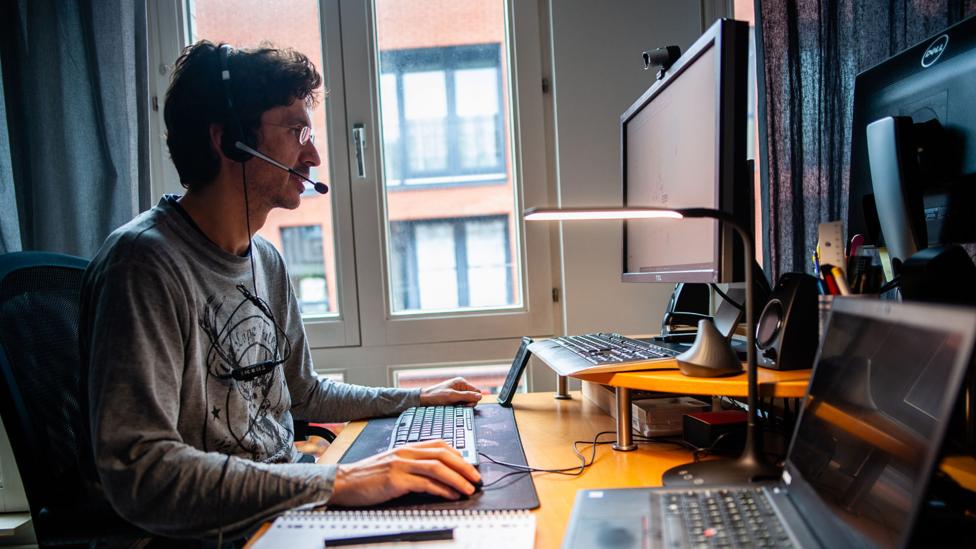Not everyone has home offices. But there are still ways to help your body avoid strain with these expert ergonomics tips.
“You can’t be productive when you’re in pain.”
That’s what Dr Susan Hallbeck, PhD says – she’s a doctor and the president of the Human Factors and Ergonomics Society and researcher at the Mayo Clinic, one of the largest academic medical centres in the US. Ergonomics is the study of how humans interact with the physical systems in their environment: how, for example, we sit at our desks for eight hours a day at work. And how if we don’t do it correctly, it can lead to physical problems and pain.
Now that we’re in the thick of the global Covid-19 pandemic, with hundreds of millions of people abruptly forced to work from home, it’s an urgent topic. Many of us are finding ourselves hunched over laptops on sofas or beds, perched on hard dining room chairs or subjecting our arms and wrists to ill-placed keyboards. For most of us, gone are the days when well-designed offices took care of all these problems for us.
So as we wash our hands and stay isolated to repel the coronavirus, how can we make sure we’re not subjecting our bodies to a different hazard caused by bad work-from-home habits? Here are the top ergonomic tips for working from home, whether it’s during a pandemic or not.
Treat your home like an office
Good ergonomic habits take practice no matter the setting, but it’s especially hard in this current situation. Perhaps, at first, your office said staff would be working remotely for a week or two, so you simply grabbed your laptop and left. That might’ve been okay for a little while – but at this point you might be asking yourself, “it’s been a month and a half, and my elbow is really starting to hurt”, says Hallbeck. “What’s up with that?”
It’s because we’re not in an office setting, which is much more likely to have the ergonomic bases covered: a computer monitor that’s at or slightly below eye level and an arm’s length away, a chair that supports your lower back and access to a mouse, which is better for your wrist than a trackpad. That’s one of the challenges we face with the pandemic, Hallbeck says. “People really didn’t think they were going to be gone for so long.”
But there are improvements you can make; if you didn’t have a bespoke home office pre-Covid, take the time to invest in accessories: a mouse, a good office chair and a standalone keyboard or monitor. If you can’t afford all those extra electronics, items lying around your house can help. If you have a standalone keyboard, for example, you can use a stack of books to raise your laptop to the right height, with the keyboard below it.
“The critical issue is to separate the keyboard from the monitor so you can get your monitor at the right line of sight: eye level or slightly below. Then adjust your keyboard or input device so that your elbow angle is around 90 degrees,” says Hallbeck, to provide proper forearm support and keep your wrists in a neutral posture.
The point here, and with all ergonomics, is to avoid what Hallbeck calls “microtraumas”: the tiny strains we put on our joints and muscles that may be invisible now, but will come back to bite us later with long-term ailments like muscular and skeletal disorders: carpal tunnel syndrome, inflamed tendons, muscle strains or finger, shoulder and back injuries.
Prepare for good posture
One issue at the moment is that many of us may be sitting at the kitchen or dining room table as we take Zoom calls or draft emails. The problem here? Dining room tables may well be the same height as office desks, but dining room chairs often sit lower than office chairs, plus you can’t adjust the height – bad news for your forearms against those hard table edges. Hallbeck says just take a small towel or washcloth “and double it up under your arms so you don’t have that pressure point”.
And if you’re sitting in one of those hard wooden chairs, Hallbeck recommends sticking a small pillow behind you at your waist to provide easy lumbar support. Make sure your back is against the chair, shoulders relaxed, and arms relaxed at 90-degree angles. “Let your furniture do the work,” Hallbeck says.
Posture is key, adds Kirsty Angerer, an ergonomics consultant based in Leicester, England, who says something called “neutral posture” should be our goal.
“This is a position of ease for the body to maintain for a prolonged period of time – where the position supports the natural curves of the spine and maintains your body in good alignment,” she says. “A position for the body that you can sustain with minimal effort and [that] gives you biomechanical advantages to do your work.
“When you have set yourself up appropriately in your chair put your hands in your lap comfortably. Where your elbow lands is the same height that you want your table top to be. To check, sit side on to your table; if you have to lift your arm to reach the table top you are too low. You should be able to slide your arm over the table without lifting your shoulder up.”
Make sure to move – including your eyes
It’s not just about your position while you sit, however. Since you’re not in an office, there’s no more walking to the printer or over to talk to a colleague, or popping down the street for lunch.
“Due to everything we need being in much closer proximity, we will naturally be moving less than when we were in the office: it’s now only a few steps to the kitchen, the bathroom, the living room and the bedroom,” says Angerer.
Non-exercise activity thermogenesis – or Neat – refers to those tiny ways we expend energy that don’t fall into the categories of sleeping, eating or sports; think things like walking around an office or even fidgeting or tapping your toes. Studies show that Neat could play a key part in maintaining our energy levels and body weight. In the new work-from-home environment, that means consciously tapping into these activities and making sure to move every 30 minutes – outside is great, but even a different room is suitable. The main goal is that you’re moving intermittently and varying your posture throughout the day to avoid strain.
Don’t forget your eyes, Angerer adds. “Our eyes are a muscle, so they need to move regularly as well,” she says. Every 20 minutes, take your eyes off your screen and focus on something 20ft away for 20 seconds, something which helps avoid eye strain.
And lighting plays a role, too. If it’s too bright in the room, it may speed up eye strain or give you headaches. If it’s too dull, you may end up in an awkward position as you try to read your screen. “You should have less light above the eyes and more light below the eyes – on the table, across the keyboard and documents,” she says. Avoid sitting right next to a window, which may cause a glare on the computer screen.
Of course, for those locked down in tiny flats or sharing space with roommates, creating a full home office will not be realistic – in fact many people will be working on sofas or on their beds. Hallbeck says that on a bed, use pillows to support your lower back, place a pillow under your thigh[s] to reduce pressure on your lower back, create a tray to put your laptop on, put your monitor slightly below eye level and keep elbow angles at 90 degrees. But ideally, you should really be sitting at a table or desk: “If you can avoid the bed or couch, avoid it,” she says.
Pay attention for pain
The basic idea with these tips is to take small steps to protect your body. It depends on the person, but bad habits in your twenties may not cause real problems until your fifties. Everyone’s body is different, which is why you need to be as conscientious as possible. And if you feel pain, take that as a signal: something clearly isn’t working. “People should pay attention to their bodies,” Hallbeck says.
One of the lasting effects of Covid-19 could be that more companies will allow people to work from home in the future. So being mindful of WFH ergonomics could end up being a skill we’ll use permanently.
“I think companies are going to re-assess what can and can’t be done from home – office space is expensive. I think that’s going to be something that comes out of this pandemic,” Hallbeck says. “A reassessment of what it means to work from home… and what a home office looks like. People are going to have to learn how to set up their ergonomic settings themselves.” (BBC)





